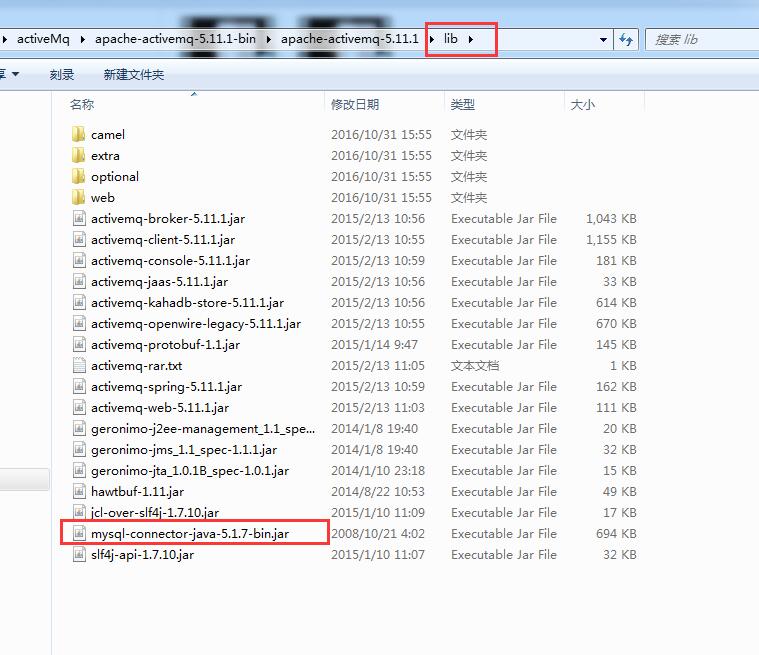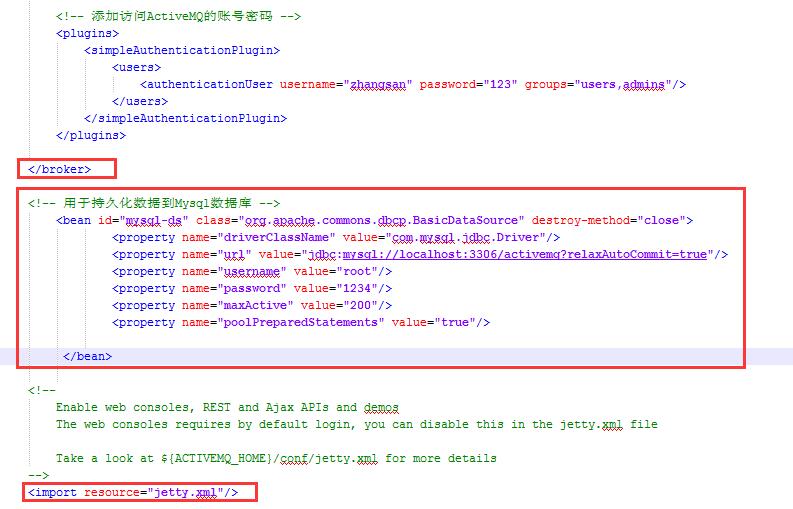ActiveMQ的消息持久化到Mysql数据库
2016-11-01 20:50
423 查看
1、将连接Mysql数据库的jar文件,放到ActiveMQ的lib目录下

2、修改ActiveMQ的conf目录下的active.xml文件,修改数据持久化的方式
2.1 修改原来的kshadb的持久化数据的方式
2.2 连接Mysql的配置(注意配置文件放置的位置)

3、将数据持久化Mysql的运行截图
3.1 重新启动ActiveMQ,并运行程序,放入持久化数据,查看Mysql的active数据库

4、放入持久化数据的代码

2、修改ActiveMQ的conf目录下的active.xml文件,修改数据持久化的方式
2.1 修改原来的kshadb的持久化数据的方式
<persistenceAdapter>
<!-- <kahaDB directory="${activemq.data}/kahadb"/> -->
<jdbcPersistenceAdapter dataSource="#mysql-ds"/>
</persistenceAdapter>2.2 连接Mysql的配置(注意配置文件放置的位置)
<!-- 用于持久化数据到Mysql数据库 --> <bean id="mysql-ds" class="org.apache.commons.dbcp.BasicDataSource" destroy-method="close"> <property name="driverClassName" value="com.mysql.jdbc.Driver"/> <property name="url" value="jdbc:mysql://localhost:3306/activemq?relaxAutoCommit=true"/> <property name="username" value="root"/> <property name="password" value="1234"/> <property name="maxActive" value="200"/> <property name="poolPreparedStatements" value="true"/> </bean>

3、将数据持久化Mysql的运行截图
3.1 重新启动ActiveMQ,并运行程序,放入持久化数据,查看Mysql的active数据库

4、放入持久化数据的代码
import javax.jms.Connection;
import javax.jms.ConnectionFactory;
import javax.jms.DeliveryMode;
import javax.jms.Destination;
import javax.jms.MessageProducer;
import javax.jms.Session;
import javax.jms.TextMessage;
import org.apache.activemq.ActiveMQConnectionFactory;
public class Sender {
public static void main(String[] args) throws Exception {
// 1、建立ConnectionFactory工厂对象,需要填入用户名,密码,以及连接的地址
// 仅使用默认。端口号为"tcp://localhost:61616"
ConnectionFactory connectionFactory = new ActiveMQConnectionFactory(
"zhangsan",// ActiveMQConnectionFactory.DEFAULT_USER,
"123",// ActiveMQConnectionFactory.DEFAULT_PASSWORD,
"tcp://localhost:61616");
// 2、通过ConnectionFactory工厂对象创建一个Connection连接
// 并且调用Connection的start方法开启连接,Connection默认是不开启的
Connection connection = connectionFactory.createConnection();
connection.start();
// 3、通过Connection对象创建Session会话(上下文环境对象),
// 参数一,表示是否开启事务
// 参数二,表示的是签收模式,一般使用的有自动签收和客户端自己确认签收
// 第一个参数设置为true,表示开启事务
// 开启事务后,记得要手动提交事务
Session session = connection.createSession(Boolean.TRUE,
Session.CLIENT_ACKNOWLEDGE);
// 4、通过Session创建Destination对象,指的是一个客户端用来指定生产消息目标和消费消息来源的对象。
// 在PTP模式中,Destination指的是Queue
// 在发布订阅模式中,Destination指的是Topic
Destination destination = session.createQueue("queue1");
// 5、使用Session来创建消息对象的生产者或者消费者
MessageProducer messageProducer = session.createProducer(destination);
// 6、如果是,生产者,使用MessageProducer的setDeliverMode方法设置,消息的持久化和非持久化
messageProducer.setDeliveryMode(DeliveryMode.PERSISTENT);
// 7、最后使用JMS规范的TextMessage形式创建数据(通过Session对象)
// 并利用MessageProducer的send方法发送数据
for (int i = 0; i < 5; i++) {
TextMessage textMessage = session.createTextMessage();
textMessage.setText("我是消息" + i);
messageProducer.send(textMessage);
}
// 手动提交开启的事务
session.commit();
// 释放连接
if (connection != null) {
connection.close();
}
}
}
相关文章推荐
- ActiveMQ系统之——消息持久化到MySQL数据库中(二)
- ActiveMQ消息持久化到Mysql数据库
- JMS消息持久化,将ActiveMQ消息持久化到mySql数据库中
- JMS消息持久化,将ActiveMQ消息持久化到mySql数据库中
- ActiveMQ消息持久化到Mysql数据库
- [jms那点事儿] JMS ( java message service )入门 + activemq消息持久化
- ActiveMQ学习记录 之 消息持久化
- ActiveMQ使用MySQL进行消息持久化
- JMS服务器ActiveMQ的初体验并持久化消息到MySQL数据库中
- ActiveMQ入门到精通4-消息持久化到Mysql
- ActiveMQ中的消息的持久化和非持久化 以及 持久订阅者 和 非持久订阅者之间的区别与联系
- ActiveMQ - 持久化消息与持久主题订阅
- ActiveMq笔记2-消息持久化
- Apache ActiveMQ 持久化到MySQL数据库
- 快速上手MQ之activeMQ(4)--消息持久化
- ActiveMQ 消息持久化到数据库
- JMS服务器ActiveMQ的初体验并持久化消息到MySQL数据库中
- JMS服务器ActiveMQ的初体验并持久化消息到MySQL数据库中
- JMS服务器ActiveMQ的初体验并持久化消息到MySQL数据库中
- ActiveMQ消息持久化
